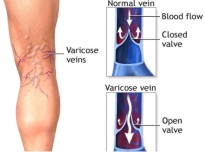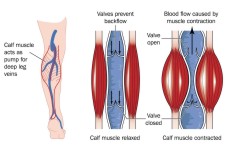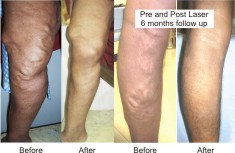Quick Links
Varicose Veins

What are varicose veins?
Varicose Veins are abnormally swollen and large veins in the legs, usually due to defective valves in the vein. Varicose veins are sometimes bluish in color, protrude from the surface of the skin, and frequently have a winding or worm-like appearance.
Normally, blood circulates from the heart to the legs via arteries and back to the heart through veins. Veins contain one-way valves which allow blood to return from the legs against gravity. If the valves leak, blood pools in leg veins which can become enlarged or varicose.
Endovenous LASER ablation is an image-guided procedure that uses heat generated by laser energy to seal off these faulty vessels, diverting blood flow immediately to nearby healthy veins.
Risk factors for developing varicose veins

Age: The risk of varicose veins increases with age
Sex: Women are more likely to develop the condition. Hormonal changes during pregnancy, premenstruation or menopause may be a factor
Family history: If other family members had varicose veins, there's a greater chance you will too.
Obesity: Being overweight puts added pressure on your veins.
Standing or sitting for long periods of time. Your blood doesn't flow as well if you're in the same position for long periods.
What are the symptoms of varicose veins?

Tests to diagnose varicose veins
To diagnose varicose veins, your doctor will do a physical exam, including looking at your legs while you're standing to check for swelling. Your doctor may also ask you to describe any pain and aching in your legs.
You may also need a colour doppler test to see if the valves in your veins are functioning normally or if there's any evidence of a blood clot.
Can I be cured of my varicose veins?
Varicose veins can be successfully treated. Endovenous ablation is an image-guided procedure that uses heat generated by laser energy to seal off these faulty vessels, diverting blood flow immediately to nearby healthy veins. Most of the times as an OP procedure.
How does the procedure work?
Using ultrasound to visualize the enlarged vein, a catheter or vascular access sheath is inserted through the skin and positioned within the abnormal vein. The laser fiber is then inserted through the catheter and advanced to the desired location. Laser energy is then applied, heating the vessel and causing it to close. Following the procedure, the faulty vein will shrink and disappear in due course.”
How is the procedure performed?

Image-guided, minimally invasive procedures such as endovenous ablation are performed by a specially trained interventional radiologist.
The leg being treated will be cleansed with alcohol based soap, sterilized and then covered with a sterile surgical drape.
A very small nick is made in the skin at the desired site.
Using ultrasound guidance, the catheter is inserted through the skin into the vein and positioned within the abnormal vein. The laser fibre is then inserted through the catheter and the tip of the fibre is exposed slightly.
Local anesthetic is injected around the abnormal vein with ultrasound guidance. Laser energy is applied as the catheter is slowly withdrawn.
Pressure will be applied to stop any bleeding and the opening in the skin is covered with a cotton bandage. No sutures are needed.
This procedure is usually completed within two hours.
What will I experience during the procedure?

The area of your leg that will be treated will be cleaned and then numbed. You will feel a slight pin prick when the local anesthetic is injected. The area will become numb within a short time. You may feel slight pressure when the catheter is inserted but with no serious discomfort.
Injection of local anesthetic around the abnormal vein is the part of the procedure with some amount of discomfort because it usually requires multiple injections along the course of the vein. Actual closure of the vein with the laser causes no discomfort.
Following the procedure, you will need to wear a crepe bandage to help reduce bruising, tenderness.
You may resume your normal activities the next day, with the exception of prolonged sitting or standing as well as strenuous activities. You should remain active and not spend too much time in bed during the recovery period since this increases the chance of complications.
How follow up is done?

A follow up colour Doppler examination is done in order to assess the treated vein and to check for any adverse outcomes. Additional procedures such as sclerotherapy, may be necessary to treat associated veins.
What are the Benefits Vs Risks?
Benefits:
Risks:
